Why being need-oriented, not solution-oriented, is crucial to build a useful and sustainable Product

In the world of product development, conversations often gravitate—sometimes far too early—toward solutions: a new feature to build, a redesigned interface, a tool to integrate. This “solution-first” mindset is common. It feels reassuring. It creates the illusion of progress. But it can also be a trap.
1. The Solution Illusion: A Common Human Bias
Even users fall into this trap. When asked open-ended questions about their frustrations or challenges, they often respond with a proposed fix:
- “We need a button here.”
- “I want a mobile app.”
- “A dashboard would be great.”
Why this reaction?
- Fear of change. Suggesting a solution similar to what they already know feels safer.
- Desire for clarity. Thinking in terms of features gives them a sense of control and immediacy.
But that’s exactly the risk: by jumping to solutions, we might end up optimizing something that shouldn’t even exist in the first place. We polish the wrong thing.
2. Refocusing on the “Why”: Understand the Need Before Defining the How
Building a product means solving a real problem. If we skip that step, we risk creating flashy but useless tools.
So the essential question becomes: What problem are we trying to solve?
As Simon Sinek explains in « Start With Why », the most resilient companies and products are those that start with a clear sense of purpose—their “why.” That clarity aligns teams, drives motivation, and ultimately creates lasting value.
“People don’t buy what you do, they buy why you do it.”
In short: if the need isn’t clear, the solution will likely miss the mark—or worse, be irrelevant.
3. How to Shift to a Need-First Mindset
Moving from a solution-focused to a need-focused approach requires a change in mindset. Here are some practical methods:
🔍 Use the 5Ws Framework
A simple yet powerful set of questions:
- Who is affected by this problem?
- What are they trying to achieve?
- Why does this matter? What happens if it’s not solved?
- When does the issue occur?
- Where does it happen? In what context?
This framework helps you step back and understand the user’s situation before jumping to conclusions.
🗣️ Conduct User Interviews That Focus on Needs
Ask questions like:
- “What’s stopping you from making progress right now?”
- “What exactly are you trying to do?”
- “How are you currently handling this? What’s not working for you?”
The goal isn’t to hear what users want, but to understand why they want it.
🎯 Anchor Every Solution to a Clear Problem
When someone proposes an idea, always ask: “What core problem does this solve?”
If there’s no clear answer, it’s time to go back to the user’s reality—their goals, constraints, and frustrations.
4. Step Outside the Box to Rethink the Box
A need-focused approach also opens the door to true innovation. Sometimes, the current system is fundamentally broken or outdated. Only by stepping back and questioning it can we find a better path forward.
“If I had asked people what they wanted, they would have said faster horses.” — often attributed (though likely apocryphally) to Henry Ford
This quote captures the essence of the problem: a solution-first mindset locks us into the current frame. A need-first mindset helps us redesign it entirely.
Conclusion:
A Product Isn’t Just a Set of Features — It’s a Response to a Real Need
Product design isn’t about checking off a list of functionalities. It’s about solving meaningful problems, for real people, in a specific context—with clarity and purpose.
Always start with the need. Let the solution follow.
That’s how truly valuable products are born!
